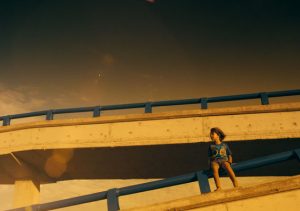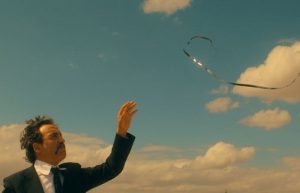For the third successive year, Moroccan director Hicham Lasri found himself being welcomed by festival audiences in Berlin, as his fifth feature film, Headbang Lullaby (2016) – following Starve Your Dog in 2016 and The Sea is Behind in 2015 – made its world premiere in the Panorama Special section of the 2017 Berlinale. The film has also been screened this past week at the National Film Festival in Tangiers and is a Moroccan-French co-production that also befitted from funding from the Doha Film Institute (Qatar).
It is worth dwelling for a moment on just what a significant achievement this is. There can be few contemporary filmmakers from anywhere in the world whose work has appeared in three successive editions of the Berlinale. The fact that Lasri has become a regular in the Panorama section of one of world’s most important film festivals is testament to his originality, energy and creative vision as an emerging Moroccan auteur; factors that undoubtedly play well with cinephile festival audiences. This is especially true of the Panorama section of the Berlinale, which, by the festival’s own admission, aims to ‘offer insights on new directions in art house cinema’ and where auteur films such as Lasri’s traditionally form the heart of the progamme.

However, the frequency of Lasri’s recent appearances at the Berlianle is also more than that. It is an indication of how his particular style of low-budget, auteur-led production allows him to move rapidly from development to production and post-production in the time that other filmmakers are still agonizing over the first draft of their screenplay. Given how rare Lasri’s considerable success at the Berlinale over the past three years has been, it is surprising that he has not received more recognition for this achievement either within Morocco or from the CCM. There was no mention, for example (or none that I could see) of Lasri’s success at the Moroccan stand run by the CCM in the European Film Market in Berlin, whereas other national film agency stands in the market were falling over themselves to highlight the success of their national filmmakers at the festival. One possible explanation for this could have to do with the fact that Lasri was controversially denied the final tranche of funding (worth more than 1 million MAD) of the avance sur recettes, because the final proposed edit of the film was – according to the communication to the director from the CCM – deemed to have been too far removed (“especially in terms of the quality of production”) from the project as it was originally submitted to the commission for the avance sur recettes. [For more information on this: click here].
The screening of Headbang Lullaby that I attended in a cinema just off Postdamer Platz, at the centre of the festival site, was enthusiastically received by a near-capacity crowd and followed by a Q&A with the director and members of the cast. Headbang Lullaby continues the experimentation with form and style as well as the concern with recent Moroccan history found in Lasri’s earlier works, maintaining the (by now characteristic) frenetic energy of the mobile camera combined with striking composition. His work is also reminiscent of one of the greatest of all African filmmakers, Djibril Diop Mambety, who chose to apply his distinctive creative style to scenarios where magical realism and the surreal or absurd collide with the everyday struggles and political realities facing ordinary and often forgotten members of African society. The main difference, I would say, between the two directors is that Lasri is less successful in achieving the emotional connection with the characters that was always present in Mambety’s films.
In fairness to Lasri, however, in Headbang Lullaby this distanciation from the main character is partly the point. Daoud, a world-weary policeman who sustained a head injury during the bread riots of 1981, has been left with a metal plate in his head as a result of the injury and a neurological condition, which means he is unable to register emotion. A few years after the injury and set against a backdrop of Morocco’s famous but unexpected victory over Portugal in the 1986 World Cup in Mexico, Daoud is sent on a mission to guard an architecturally elaborate but seemingly pointless bridge over a highway that separates two small villages, whose inhabitants are openly hostile towards one another. The pretext of Daoud guarding the bridge is to maintain order between the villagers as Hassan II and his entourage are expected to travel on the road. This information has been transformed by the local rumour mill into the ‘fact’ that Hassan II has the express intention of visiting both villages, thus causing excitement amongst the villagers and hurried preparations to welcome the king’s arrival.

In cinematic terms, the film’s use of colour (the brightly coloured plastic ribbons on top of the bridge that fly in the wind), camera movement, composition and strange/extreme camera angles, render the mundane and functional space of the bridge as a surreal, almost psychedelic frontier between the neighbouring villages – a point of conflict and unexpected contact between Daoud and the locals he comes into contact with.
TRAILER: click here.
Whilst maintaining Lasri’s interest in mining the more painful aspects of Morocco’s recent past, whose impact and effects continue to resonate today, the film is nonetheless interspersed with moments of physical comedy and lighter humour than that which tends to be found in his earlier films. As Lasri acknowledged in the Q&A following the festival screening, it was important for him to allow his characters the ability to look up; to raise their heads and acknowledge the vast blue sky above them – refusing their status as downtrodden and atomized victims of history or society and embracing the possibilities of forging meaningful connections on a human and societal level. The final moments of Headbang Lullaby thus allow for a glimpse of genuine community amongst different sections of Moroccan society (albeit presented in allegorical form) and the possibility of reconciliation and moving beyond the divisive violence of the past.
Ultimately, as one reviewer at the Berlinale noted, for all of Headbang Lullaby’s visual inventiveness and creativity, the narrative’s ‘lack of clear focus and opaque message might prove a challenge for wider audiences’. There is also a question as to how far local Moroccan audiences will find Lasri’s auteurist approach accessible, presuming that they are able to see the film in Moroccan cinemas. However, as the endorsement for the third year running from the Berlinale shows, and judging by the apparently positive response to the film at the National Festival (according to other members of the TMC team who were able to attend Tangiers), in Hicham Lasri, Moroccan cinema has a dynamic and experimental auteur whose style seems, unfortunately, to be the exception that proves the rule. It is to be hoped that the CCM and Moroccan cinema more generally find the structures and identify the funding that can support the emergence of a new generation of Moroccan filmmakers who share Lasri’s creativity and originality and can find a space both at home and abroad for their work to be recognized.
Will Higbee